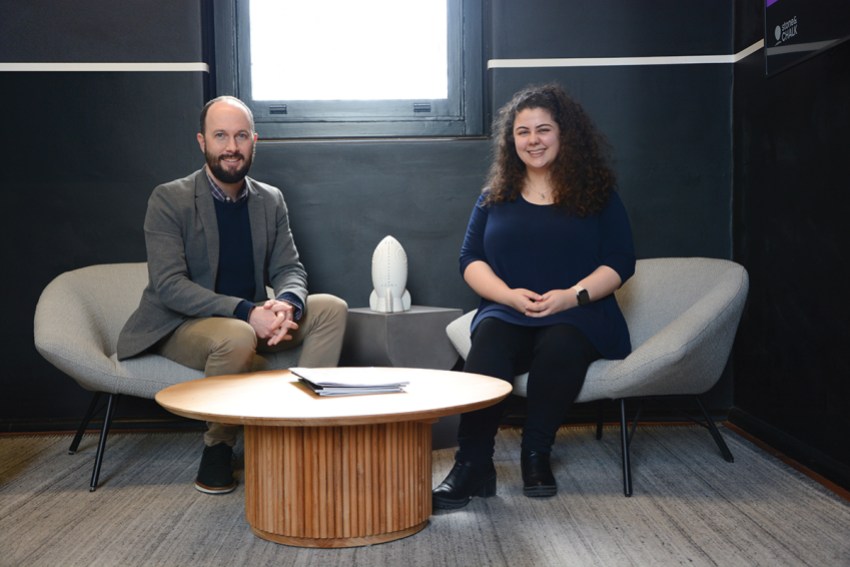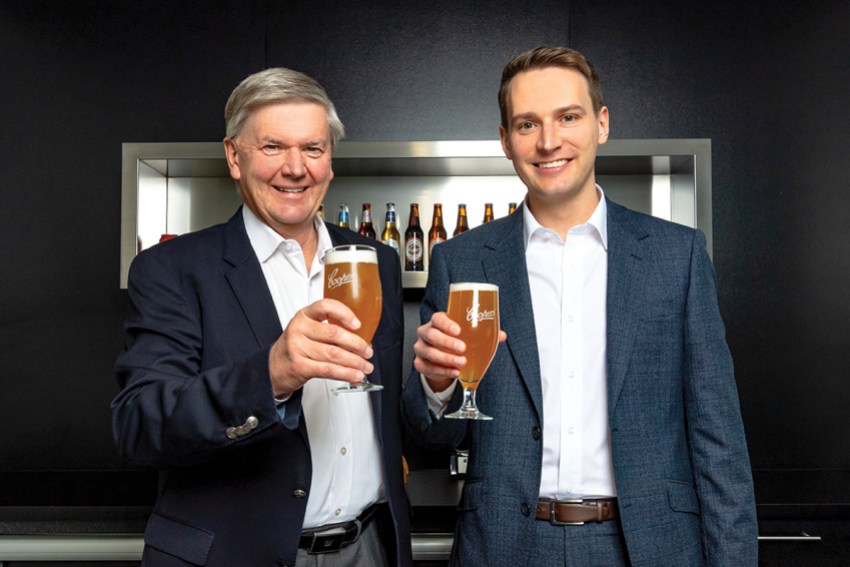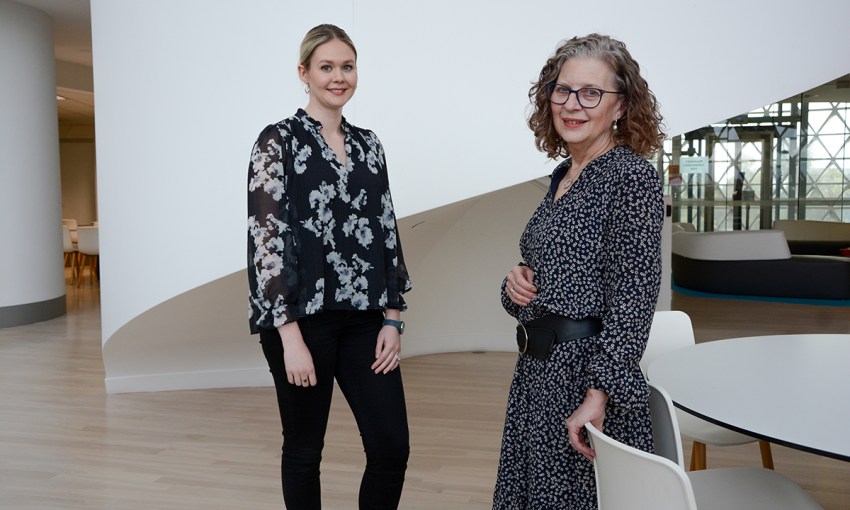The best kind of working relationships are those that combine new perspective and rich experience. We went to a few industries in South Australia to explore how members of the established workforce and those in the early stages of their career are learning from each other.
Words from the wise
Deborah White & Elyse Page
Professor Deborah White co-leads the Precision Cancer Medicine team at SAHMRI and in 2016, she met Elyse Page, 27, who is now a junior member of her Acute Lymphoblastic Leukaemia team. Elly was immediately inspired by one of Deb’s lectures and she’s worked tirelessly to be part of Deb’s team – just as Deb has fought to have her there.
How did you get into the profession, Elyse?
Elyse Because of Deb, actually. I did an undergraduate degree in science and Deb came to give three of my bio-chem lectures and I fell in love with the topic. I approached Deb and asked to do a placement in the lab, which was successful and continued after my undergrad and started a master of philosophy and upgraded to a PhD, which I did in this lab and continued on as a post doc.
Deb I can remember thinking she was slightly crazy – in a nice way. Elly came in without a scholarship and I remember thinking, we’ve got to get you a scholarship. But it showed the dedication. Do you want to talk about your dad, Elly?
Elyse When I was a child, my dad had lymphoma. That definitely drove me towards blood cancer research. He relapsed in 2020 – he’s doing well, he’s all good now – but that was at the time when I finished my PhD and was looking for a job. A lot of people looking who finish their PhD will go overseas or interstate for post-docs but I was able to have the opportunity to stay here to do a post-doc and to support my dad as well.
Deb We then went to the Simone family, a major donor, spoke to them and Elly became their fellow.
How did you enter the industry, Deb?
Deb Straight from school, I went to SA Pathology – what was IMVS. I took the job in haematology, decided to start studying part time and the rest is kind of history. I think the craziest working times I’ve had, when SAHMRI was first being built, I was approached to take over as head of cancer research here. I was involved with SAHMRI, involved with SA Pathology and we had an office in the Ernst & Young building in King William Street, so I used to run between Frome Road and EY – that was the fittest I’ve ever been.
What are some of the changes over that time?
Deb The technology was slower and there was a lot more manual work. In research, we were really quite confined by technology. Everything we do now is faster, it’s probably better, but I’m not convinced all of it is better. I watch our students now try to troubleshoot, and they can’t troubleshoot. That’s not their fault. Through three years of Covid, these guys have never been in a lab. Science degrees without picking up a pipette – or rarely picking up a pipette.
Elyse It’s obviously much faster-paced now, but I feel like the expectations have risen.
Deb As a woman, things were very different. The era before me, they weren’t allowed to work.
How have things changed in terms of women in science?
Elyse Deb’s definitely changed that for our lab at SAHMRI. We’re a predominately female team, which I love being part of.
Deb I remember within haematology when the first female post-doc was employed, that would have been in the ’90s. She had a really hard time. I worked with people who lied about the fact that they were pregnant so they could keep working. I worked with nurses who had never married because they weren’t allowed to be a nurse if they were married. I’ve had many experiences where I’ve been congratulated for making it on to a committee or getting a fellowship, followed by ‘They must have been short on women’.
Deb, is there anything you’ve learnt from the younger generations?
Deb I think at times the next generation do the work/life balance thing better than we did. I was in the era when you never turned around and said, ‘I can’t keep going’. But I was also of the era when you’d have to be on call. You could be driving in on no sleep. We never had the opportunity to say no so you just learnt to keep going.
Elyse Mental health has become more of a topic and it’s become a lot more present. It’s a lot harder to push if a student doesn’t want to be pushed.
Deb If you can’t teach and tell a student when they’re wrong, I don’t know where that’s going to go. I think it’s great that people are talking about mental health and it’s great that we understand it, but if you want to be in my position, at some stage, you have to be able to develop your own skills to be in a tough workplace.
What was it about Deb that made you want to join the team?
Elyse It wasn’t just what Deb was working on, but also who Deb is – a strong, female leader. That’s what I wanted to be. She inspired confidence and hope that I could achieve that one day.
Tim Mahlberg & Isabella McCulloch

Director of Ecosystems at Stone & Chalk Tim Mahlberg calls Isabella McCulloch the “Oreo Fairy”. The in-joke refers to the 24-year-old’s incredibly kind nature – the Robinson Aerospace Systems co-founder always had Oreos to hand out to colleagues when the pair first met when Isabella was Stone & Chalk’s first ever space intern and Tim was a resident there with his former company. But it’s this community-mindedness the two share that has become the basis of a strong mentor/mentee relationship.
How did you both make your way into your industries?
Tim I moved to Adelaide in my 20s to study philosophy and psychology. One of the things I’ve been passionate about all the way through is community. All through my six years of full-time study, I volunteered – for Meals on Wheels for six years and for Big Brothers Big Sisters. I moved to Melbourne and worked in a bank, and ended up founding a community similar to here at Stone & Chalk for the bank. I moved to Sydney and did a PhD on corporate innovation and entrepreneurship. I saw what was happening in Adelaide and wanted to be part of this new wave of innovation. Then Covid hit and I was stuck waiting for a couple of years, but I met my wife and we relocated here a couple of years ago. For me, it’s always about bringing people who are passionate about things together and giving them as much support as possible. I always take time for good people and Bella’s a great example of someone who’s always thinking of other people.
Isabella I jumped straight from high school to a degree in space science and astrophysics thinking I knew what I wanted to do. Then I did an Honours in science innovation. I went from a very technical role to one with more of a community mindset and I loved it. It was very new but it was awesome because I basically got to carve my own honours project where I ended up mapping South Australia’s space start-up ecosystem.
I founded the space society at university with the intention of bringing students into what is now our space industry and then whilst doing that, I was going to networking events and I grew really familiar with Lot Fourteen. I became a space communicator at the Australian Space Discovery Centre and applied to be space intern at Stone & Chalk.
As a woman in STEM, I’m not going to lie, it was tough to work alongside this boys club, especially in physics. I had three female friends in a class of 20.
Best lesson from Tim?
Isabella Tim is one of the few people who have taught me how to draw boundaries. I still think I go above and beyond, but I used to be someone who was working five jobs and studying full time. At one point, he made me practice saying no.
Tim It starts with an “n” and ends with an “o”.
Isabella Even though that’s something so simple, as a woman in STEM, we’ve been encouraged to go above and beyond because we’ve got to be the point of difference. As much as it’s fantastic being able to stand out from the crowd, it’s so overwhelming and difficult to keep up. I burnt out after my honours because there were all these opportunities I didn’t say no to. I was so grateful for them, but my body couldn’t physically handle it all.
Another important lesson from Tim is always be kind. Sometimes the industry can feel like it’s stabbing you in the back so having people like Tim around gives me not only faith in humanity, but the industry. Start-ups are very cut throat – there are so many hurdles and difficulties. It feels like he’s always there having his team’s back and you don’t always see that.
What inspires you about Isabella?
Tim Bella’s in an industry that typically has a lot of men in it and it has been a closed club for a while so Bella’s a bit of a shining star in the space ecosystem and I think because she is different – and while she does apologise a lot – is unapologetically herself. I think that’s refreshing and for me, being able to see that, and recognise that it’s not easy to be different when you’re in an ecosystem of people who often think about themselves or where their next step up is. I see Bella look at the people coming and support them. I think we all have a responsibility to empower new pathways, not just the existing ones.
Tim Cooper & Iain Cooper

Iain Cooper has become the latest Cooper family member to join the iconic South Australian family brewery and just a couple of months into his role as technical brewer, he sits down with his dad and the company’s managing director, Dr Tim Cooper, to visit memory lane and chat about the path ahead.
How did you decide you were going to join the family business?
Tim In 1973 when I was doing my last year at school, my father asked me what I wanted to do and I said I’d study mechanical engineering and I’d go into the brewery. He said, “No, you can’t do that, the brewery’s in the doldrums.” I studied medicine and in ’81 I went to the UK to work as a doctor with the NHS. It wasn’t until towards the end of 1985 that he was visiting and he asked if I’d be interested in coming back to Adelaide to pay some attention to the brewery because the company’s financial difficulties had turned around. I did a one-year brewing course with the University of Birmingham the last year they ran it after nearly 100 years. I developed an interest in brewing but still didn’t move back to Adelaide until 1990 because I was in two minds about whether I was going to go into brewing or continue medicine for a bit longer.
What was it about brewing that lured you?
Tim My father-in-law asked me that same question and I said, “If I was successful becoming a cardiologist and I was run over by a bus, the next day there’d be another cardiologist to take my place. I go back to Adelaide and I’m successful in the company, I will be able to keep it going and hand it over to the next generation.” He said to me, “A very romantic notion.” I don’t think he was particularly convinced. He came out to Adelaide 11 years later and looked around the brewery here at Regency Park and said, “I think you made the right decision.”
What were some of the changes that occurred between your father discouraging and encouraging you to join the family business?
Tim They had invested in lager production in the late ’60s and that’s what caused some of the headaches because they weren’t making enough money out of selling beer to pay off the debt. The thing that made the biggest difference from a functional and financial perspective was the fact that they got into home brewing. From ’77 to the mid-’90s, the company had survived reasonably well on the back of home brew. From the mid-’90s onwards the beer started doing well again.
Iain, what are your first memories of Coopers?
Iain I used to walk around with Dad at Leabrook – the old brewery site. When I was young, the bottling line was much less advanced and slower, so Dad was able to put me in a wooden box and push me along the line like a little rollercoaster, which you absolutely could not do now.
What are some of the other changes from your early days, between when you each started at Coopers?
Tim The employees used to be able to drink on the job, so that’s changed. But they used to be able to have a pint of beer – which could be stout with 6.8 per cent alcohol – at morning smoko, a pint at lunch time, a pint at afternoon smoko and a pint after work. All that came to an end in 1994 with new OH&S rules saying you couldn’t condone people drinking on the job anymore, especially if they’re working with dangerous equipment. The employees now get a carton a week to take home.
Also, the volumes we do now are so much greater. When I joined in 1990, we were doing 500 bottles a minute and now we do 1200 bottles a minute.
What’s the best piece of advice your dad has given you?
Tim When I was interested in studying brewing, Dad said to me he thought it was very important we have Coopers that understand the brewing process. Maxwell, Dad’s uncle, was the first Cooper to study brewing, so the family had gone a long time without any qualified brewers.
What qualities do you see in Iain that make him great for the job?
Tim I think it’s fantastic he’s got the education. I think what’s really important is that he’s a good communicator. We threw him in the deep end as the MC for our Coopers Foundation Golf Day the week after he started and he’s shown he can do things like that very well.
Do you still learn from the younger generation?
Tim Absolutely. Everything keeps on changing and that seems to have accelerated over time. The pace of change doesn’t ever slow and part of that is the explosion in IT and social media. I certainly learn from young people about what practical benefits can come from social media. At times to me, it seems like wrestling with a crocodile, but if you can use it to your advantage, it’s definitely a good marketing tool.
What’s exciting you about the future?
Iain I’m very excited for the whiskey. I’ll spend my whole career just getting that started because of the nature of whiskey.
Tim I’m pleased that I’m here as Iain starts. It might not have happened because he was working with Carlsberg and they offered him another three years. Every week, we have to taste the products we’re going to release – it’s a necessary job, someone’s got to do it – so Iain’s part of that team.



